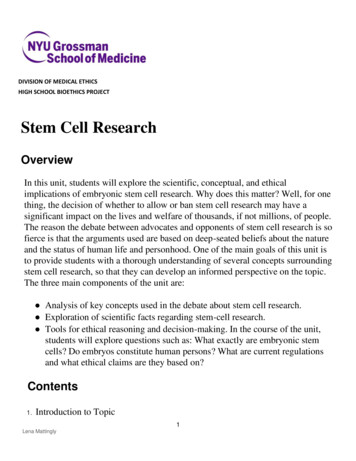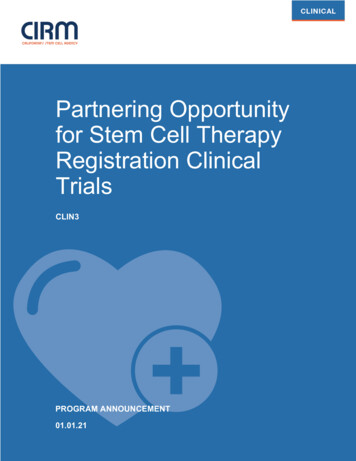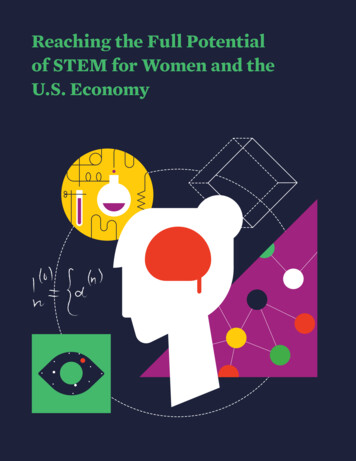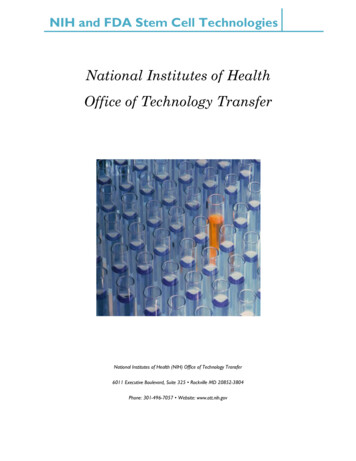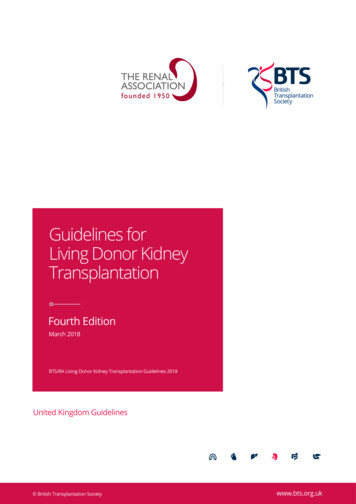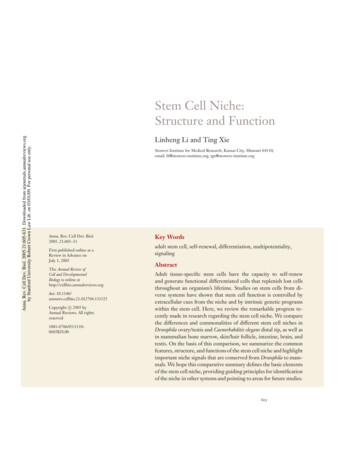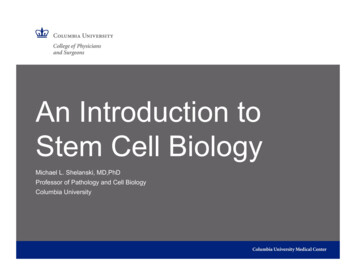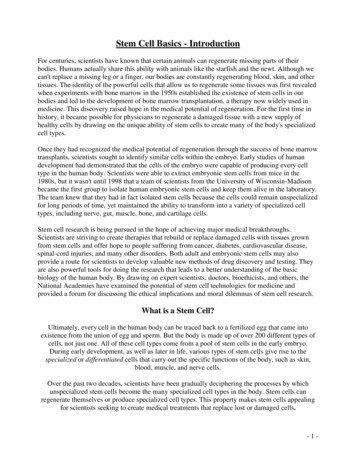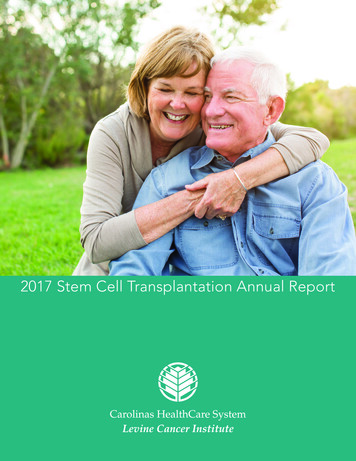
Transcription
2017 Stem Cell Transplantation Annual Report
OverviewAt Carolinas HealthCare System’s Levine Cancer Institute, we established the AdultStem Cell Transplant Program in 2012. Our program specializes in matched, related andhaploidentical transplants with a comprehensive quality management program, advancedcell processing laboratory and a stem cell collection unit. In March 2014, we performedour first transplant and received accreditation March 2016 from the Foundation for theAccreditation of Cellular Therapy.With over 20 locations throughout the region, including the site at Carolinas MedicalCenter in Charlotte, NC, Levine Cancer Institute’s success is driven by the impact we haveon our community and the patients we serve through innovation and clinical research.
OverviewAt Carolinas HealthCare System’s Levine Cancer Institute, we established the Adult Stem Cell TransplantProgram in 2012. Our program specializes in matched, related and haploidentical transplants with acomprehensive quality management program, advanced cell processing laboratory and a stem cellcollection unit. In March 2014, we performed our first transplant and received accreditation March2016 from the Foundation for the Accreditation of Cellular Therapy.With over 20 locations throughout the region, including the site at Carolinas Medical Center inCharlotte, NC,Levine CancerInstitute’s success is drivenby the impact we have on our community andStemCellTransplantsPerformedthe patientsserve throughinnovationand clinicalMorethan we20,000stem celltransplantsareresearch.performed annually for s in the United States. Of these transplants, approximately 60 percent areallogeneicand stem40 percentare autologous.More than 20,000cell transplantsare performed annually for hematologic malignancies in theUnited States. Of these transplants, approximately 60 percent are allogeneic and 40 percent areautologous.At Levine Cancer Institute, autologous and allogeneic transplants have been increasingAt Levine Cancer Institute, autologous and allogeneic transplants have been increasing annually withannuallywith most allogeneic transplants relying on haploidentical donor sources.most allogeneic transplants relying on haploidentical donor sources.Table 1Table 1 Transplants Performed at Levine Cancer Institute 2014-1017Transplants Performed at Levine Cancer Institute 90 (70.11percent)MRD5107325 (9.23percent)Haploidentical101726356 (20.66percent)Total60 (22.14percent)81 (29.89percent)104 (38.38percent)26 (9.59percent)271 (100percent)*Transplant statistics through March 30, 20171
Transplantation Survival Outcomes by TypeTransplantation Survival Outcomes by TypeAutologous transplantation is generally performed for plasma cell disorders, mainly multiple myeloma,Autologoustransplantationis generallyperformedplasmacell disorders,mainlyandrelapsed h-dosechemotherapyandmultipleuses tationreliesuponhigh-dosepatient’s own stem cells to rescue the patient’s marrow from this chemotherapy. At the data cutoff ofchemotherapyand usesthe patient’sownstemto rescue transplantationthe patient’s marrowfromwerethisApril21, 2017, 100-dayand one-yearsurvivalratesin cellsthe autologouspopulationchemotherapy.At thedata respectively.cutoff of April 21, 2017, 100-day and one-year survival rates in the97.2percent and 93.6percent,autologous transplantation population were 97.2 percent and 93.6 percent, respectively.Allogeneic transplantation is usually performed for acute and chronic leukemias and sometimes forrelapsed lymphoma and multiple myeloma. Allogeneic transplantation relies predominantly upon theAllogeneictransplantationis usuallyperformedfor acuteandand sometimesimmuneeffectsof the donor’s cellsto treatthe recipient’scancer.At chronicthe dataleukemiascutoff, logeneictransplantationreliespredominantlyone-year survival rates in the allogeneic transplantation population were 91.1 percent and 74.0 percent,upon the immune effects of the donor’s cells to treat the recipient’s cancer. At the data cutoff,respectively.100-day and one-year survival rates in the allogeneic transplantation population were 91.1percent and 74.0 percent, respectively.Figure 1Figure 1Transplantation Survival Outcomes by DiseaseAs expected, patients with plasma cell disorders and lymphoma, the majority of whom receivedautologous transplantation, exhibited superior overall survival compared to leukemia patients. One-yearsurvival in the plasma cell group was 92.0 percent compared to 87.0 percent in the lymphomapopulation and 77.4 percent in the leukemia population.Figure 22
Transplantation Survival Outcomes by DiseaseAs expected, patients with plasma cell disorders and lymphoma, the majority of whom receivedautologous transplantation, exhibited superior overall survival compared to leukemia patients.One-year survival in the plasma cell group was 92.0 percent compared to 87.0 percent in thelymphoma population and 77.4 percent in the leukemia population.Figure 2Figure 3 displays the overall survival curves for plasma cell disorder and lymphoma patients undergoingautologous transplantation.Figure 3 displays the overall survival curves for plasma cell disorder and lymphoma patientsFigure 3 displays the overall survival curves for plasma cell disorder and lymphoma patients undergoingundergoing autologous transplantation.Figure 3autologous transplantation.Figure 3Figure 3
Survival Outcomes by Allogenic Transplant TypeAt the time of data analysis, matched related and haploidentical related donors (but not yet matchedunrelated donors) were being used at Levine Cancer Institute with most allogeneic transplants sourcedby haploidentical donors. Thus far, survival probability rates have been similar between thehaploidentical and matched related donor groups.Survival Outcomes by Allogenic Transplant TypeAt the time of data analysis, matched related and haploidentical related donors (but notyet matched unrelated donors) were being usedat 4Levine Cancer Institute with mostFigureallogeneic transplants sourced by haploidentical donors. Thus far, survival rates havebeen similar between the haploidentical and matched related donor groups.Figure 44
Non-Relapse Mortality at Levine Cancer InstituteNon-Relapse Mortality at Levine Cancer InstituteNon-relapse mortality (NRM) is widely accepted as the most dreaded complication of stem cellNon-relapse mortality (NRM) is widely accepted as the most dreaded complication of stem celltransplantation. For autologous transplantation, one-year and overall NRM rates have both been 2.5transplantation. For autologous transplantation, one-year and overall NRM rates have both been 2.5percent, whereas for allogeneic transplantation one-year and overall NRM rates have both been 10.7percent, whereas for allogeneic transplantation one-year and overall NRM rates have both been 10.7Non-relapse mortality (NRM) is widely accepted as the most dreaded complication ofpercent.percent.stem cell transplantation. For autologous transplantation, one-year and overall NRMrates have both been 2.5 percent, whereas for allogeneic transplantation one-year andoverall NRM rates have both been 10.7 percent.Table2Table 2Non-Relapse Mortality at Levine Cancer InstituteTable 2FigureFigure55Figure 5Figure 5 is a graphical representation of the data in Table 2.55
Graft-Versus-Host Disease ComplicationsGraft-Versus-Host Disease ComplicationsWith possible rare exceptions, graft-versus-host disease (GVHD) is a complication restricted toWith possiblerare exceptions,graft-versus-hostdisease(GVHD)is a ofcomplicationallogeneictransplantation.This diseaseentity occurs whenthe immunesystemthe donor attacks therestrictedto allogeneicdiseasethe immunebodyof the recipient.GVHD transplantation.comes in two mainThisforms– acuteentityGVHD occurs(aGVHD)whenand chronicGVHDsystem Acuteof theGVHDdonorattacksoccursthe bodythefirstrecipient.comesin two main–(cGHVD).generallywithinofthe100 HDusuallyoccurslater.acute GVHD (aGVHD) and chronic GVHD (cGHVD). Acute GVHD generally occurs withinthe first100followingtransplantation,and chronicGVHD usuallyoccurslater.AcuteGVHDcandaysbe gradedon a scalefrom 1 to 4. Thereis some evidencethat milderaGVHD(grade oneGVHD canbea gradedon aversusscaleleukemia”from 1 toeffect,4. Thereis cansomeevidencemilderorAcutetwo) correlatedwithbetter “graftwhichhelpto protectthatagainstrelapseinaGVHDpatients (gradeundergoingtransplantation.is alsosomeversusevidenceto suggestthat theoneallogeneicor two) correlatedwith Therea severe(gradethree orcan help to protect against relapse in patients undergoing allogeneic transplantation.four).There is also some evidence to suggest that the benefits of aGVHD are outweighed bycomplications when aGVHD becomes moresevere(grade three or four).Figure6Figure 6Chronic GVHD can be categorized as mild, moderate or severe and is divided as such inFigure 7.Chronic GVHD can be categorized as mild, moderate or severe and is divided as such in figure 7.Figure 7Figure 76SummaryLevine Cancer Institute is committed to improving outcomes by providing innovative and supportive
SummaryLevine Cancer Institute is committed to improving outcomes by providing innovative andsupportive care to patients with hematologic malignancies, including those undergoingstem cell transplantation. With multiple ongoing research projects, our team is focusedon advancing treatment options and improving care for our transplant patients.
Stem Cell Transplants Performed More than 20,000 stem cell transplants are performed annually for hematologic malignancies in the United States. Of these transplants, approximately 60 percent are allogeneic and 40 percent are autologous. At Levine Cancer Institute, autologous and allogeneic transplants have been increasing annually with
